By Mumtaz Alam Falahi, TwoCircles.net
TCN series on Malda and Murshidabad : Part 2
Though Muslim-dominated Malda in West Bengal today is known for poverty, illiteracy and backwardness, the city has remained capital of kingdoms – first of Hindu rulers and then Muslims – over several centuries. While grand old official buildings of the ruling class and crumbled great mosques and minarets remind one of the historic significance of the district, some clusters of mazars and graves of early preachers of Islam tell something about the advent of Islam in that part of the world.
There are two famous clusters of mazars in Pandua area of Malda district. In 1338 AD Haji Ilyas Shah, a ruler, brought the whole Bengal under his rule and made Pandua – the ancient Hindu city 20 miles northeast of Lakhnauti – the capital of Bengal. Before that, Lakhnauti or Gaur was the capital over centuries.
Some time in 12th century, during the regime of King Lakhan Sen of Bengal, Iranian emperor Tabrez’ son Syed Shah Jalaluddin Tabrezi was sent to Eastern India for the propagation of Islam. He came to Pandua and made this place his centre and began preaching Islam in entire Eastern India from here.
Bais Hazari Wakf Estate
In this Bais Hazari Wakf Estate campus, there are several graves of some friends and pupils of Syed Shah Jalaluddin Tabrezi. When the saint decided to make Pandua his centre King Lakhan Sen, who ruled from Lakhnauti or Gaur, some 10 kilometres from Pandua, gave him this Bais Hazari area.
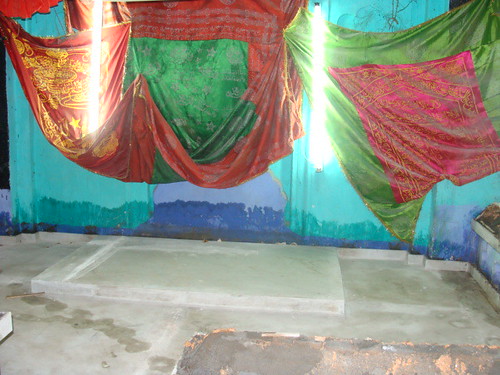
Astana of Syed Shah Jalaluddin Tabrezi
“This is astana of Syed Shah Jalaluddin Tabrezi from where he would give sermons to his pupils. Lakhan Sen had given him properties of Bais Hazari Estate for the work,” says my learned – but not professional – guide Dr Muhammad Noorul Islam Majidi when we are moving in the main building in the campus. There are many graves in the campus. They are believed to be of some of those who came with the saint from Iran and some of his friends. His own mazar is somewhere in Pandua. But it is not certain whether that is his mazar, and so it is not popular, Dr Majidi says while giving a running commentary on the surroundings.
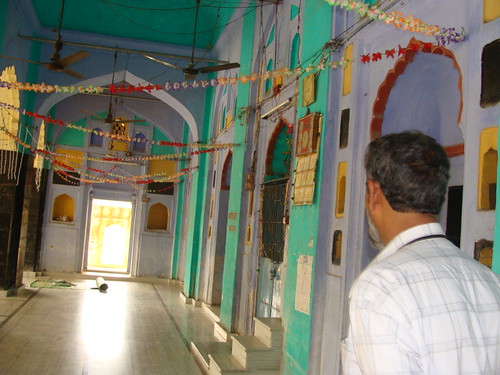
Though this campus has no grave of Syed Shah Jalaluddin Tabrezi, people have attached much religious importance to the place. People come here all year, particularly in the month of Rajab. On 22 of that month there is a grand urs in this Bais Hazari Estate which has several mazars. They offer fateha and dua. And people offer chader at a special place in the main building that has astana of saint Tabrezi.

Bais Hazari Wakf Estate in Pandua, Malda
Establishment of Muslim rule in Bengal
Muslim rule expanded to this part of eastern India following the third wave of successful invasion by Muhammad Shahabuddin Ghauri. This took place between 1191 AD and 1255 AD.
In 1202 AD when Muhammad Bakhtiyar Khilji, the lieutenant of Qutbuddin Aibak, then ruler of Delhi, took his army to Bengal. The capital city surrendered to him as the King of Bengal Lakhan Sen abandoned his capital Gaur.
According to the book “Memoirs of Gaur and Pandua” (by M. Abid Ali Khan and H. E. Stapleton), “Gaur, under the names of Ramavati and Lakshmanavati, was probably one of the royal capitals of the Pal and Sen Kings, but its recorded history does not begin until the Muhammadan conquest of western and Northern Bengal (Rarh and Varendra) by Muhammad-I-Bakhtiyar Khalji, the lieutenant of Qutbuddin Aibak of Delhi, in the year 599 of the Hijra, corresponding with 1202 A.D. Rai Lakshman Sen (better known as Lakhan Sen) who had renamed Gaur Lakshmanavati after his own name, was then King of Bengal, and Muhammad-I-Bakhtiyar, advancing rapidly by the south easterly road from Bihar, surprised him in his capital of Nadia on the Bhagirathi river (now represented by Nabadwip, a little to the west of Krishnagar).”
The author further says that Muhammad Bakhtiyar then caused the Khutbah to read, and coins struck in the name of Qutbuddin Aibak, the ruler in Delhi. After the conquest of Bengal, Muhammad Bakhtiyar established mosques, colleges and rest houses for dervishes in that province and made Lakhnauti the seat of his government.
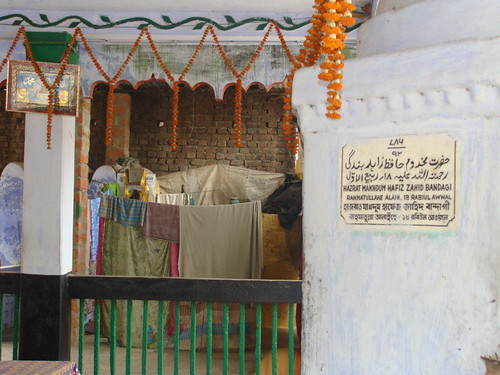
Mazar of saint Hazrat Makhdum Zahid Bandagi in Chhoti Dargah premises
From the time of Muhammad Bakhtiyar Khilji (1202-05) down to that of Qadar Khan (1325-38) Bengal formed a dependency of the throne of Delhi, but after the death of Qadar Khan in 1338 Bengal was ruled by its own Kings who were quite independent of the Delhi rule. Within the 14 years following 1338 Haji Ilyas Shah brought the whole Bengal under his rule and made Pandua the capital.
Sikandar Shah I, the son of Haji Ilyas Shah, also made Pandua his seat of government which remained with his family till about 1410 AD when Raja Kans (or Ganesh) set up a short succession of puppet kings beginning with Saifuddin Hamzah Shah in whose name he ruled.
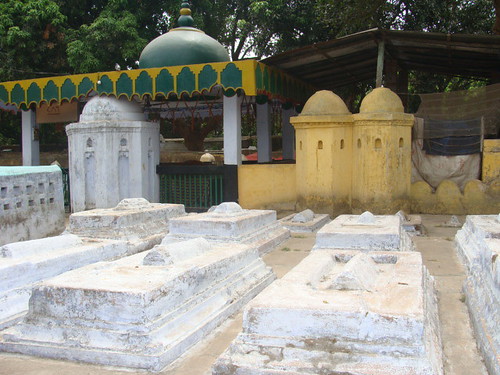
Mazars in Chhoti Dargah in Malda
Being Pandua capital of Muslim rule over long time, we find several mazars and old mosques in that area.
After Syed Shah Jalaluddin Tabrezi the renowned spiritual leader who also came from Iran and settled in Pandua was Syed Shah Makhdoom Alaul Haque Pandvi. He is also known as Pandvi Alaul Haque. His mazar is in the campus of Chhoti Dargah, hardly two kms from the Bais Hazari area.
Mazar of Shah Makhdoom Alaul Haque Pandvi

Mazar of saint Alaul Haque Pandvi in Chhoti Dargah in Malda
There is a cluster of mazars in the Chhoti Dargah. Important among them is the mazar of Shah Makhdoom Alaul Haque Pandvi who came from Iran to spread Islam in eastern India. Besides him, the Dargah has mazar of his son Noor Qutbe Alam and grandson Syed Zahid. The Dargah was the centre of propagation of Islam in the days after Syed Shah Jalaluddin Tabrezi and in the time of King Ganesh, says Dr Majidi. “By the efforts of these spiritual leaders lakhs of downtrodden people and Buddhists converted to Islam,” he says adding that one of the important persons who converted to Islam was none other than the son of King Ganesh.
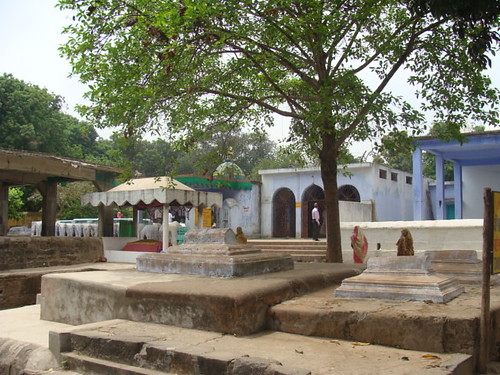
Chhoti dargah
“Noor Qutbe Alam was friend of Ganesh’s son Jadu. They studied together. Jadu converted to Islam and got the name of Jalaluddin. After the conversion King Ganesh had dispute with Shah Makhdoom Alaul Haque Pandvi. This led to the Government of India sending its army to this area. King Ganesh was defeated and fled to Dhaka now in Bangladesh. Then was established Islamic rule in Bengal and it continued for about 500 years,” Dr Majidi says.
Mazar of Jadu (Jalaluddin)
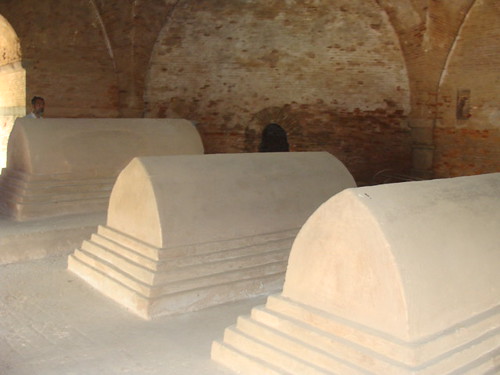
After the defeat of King Ganesh his son Jalaluddin came to the throne of Bengal in 1415 AD, and kept Pandua his capital.
In the Eklakhi mausoleum in Pandua there is the mazar of Jalaluddin, his wife and child. The mausoleum is one the most picturesque buildings of that period.

Eklakhi mausoleum

